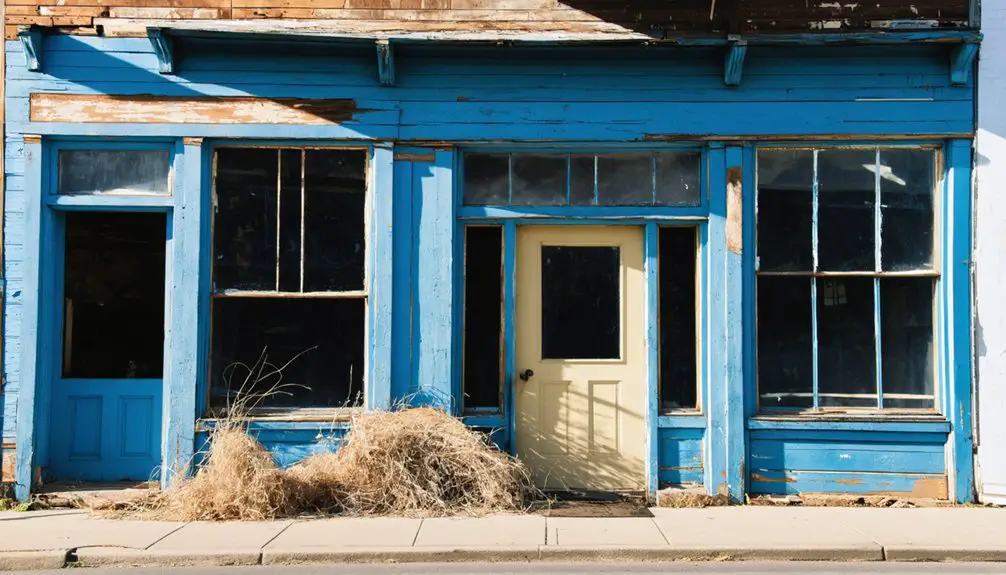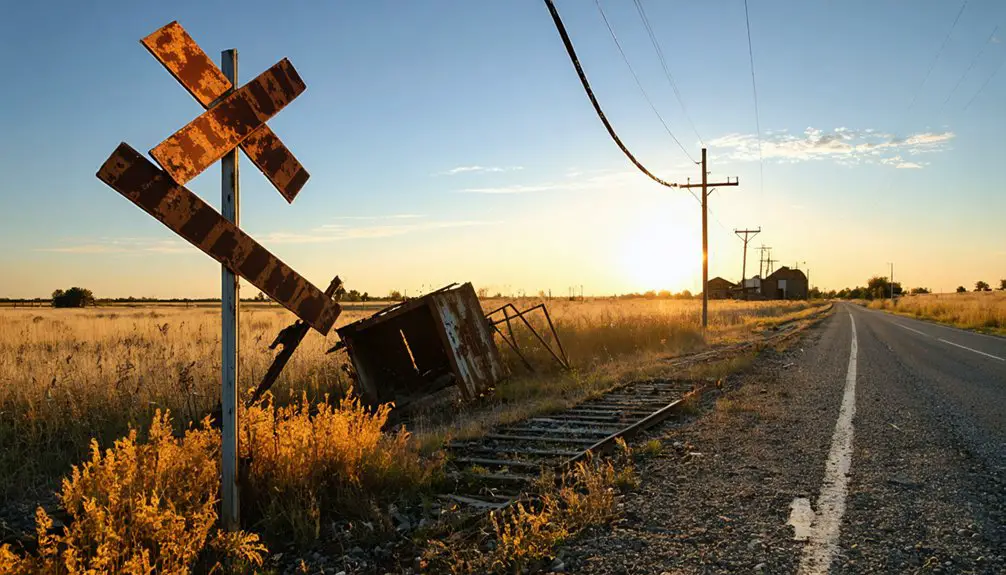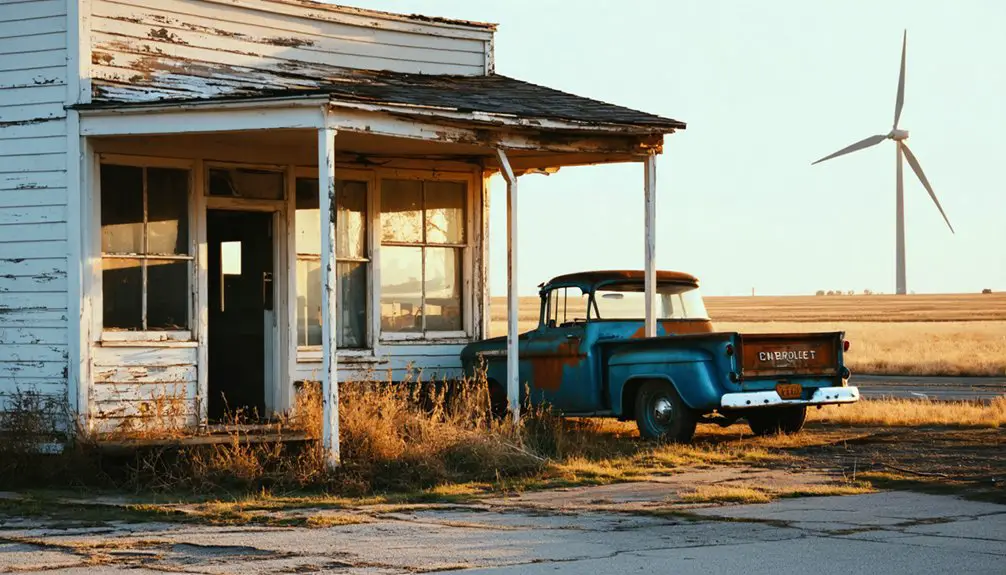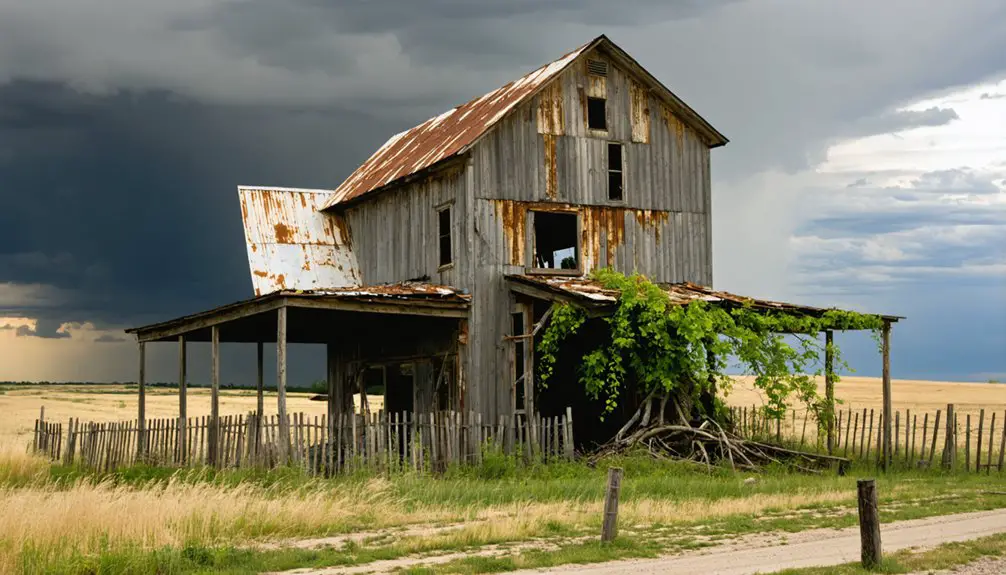You’ll find Keighley’s ghost town story began as a thriving St. Louis-San Francisco Railway stop in 1880, growing into a commercial hub with grain elevators and stores. The 1925 Tobler oil strike transformed the town, boosting its population from 30 to 500 residents. After losing its railway status that same year and experiencing the oil boom’s decline by 1928, Keighley gradually faded. Today, only a few structures remain to tell the tale of this once-bustling Kansas community.
Key Takeaways
- Keighley transformed from a bustling railroad town of 500 residents to a ghost town after losing its railway stop in 1925.
- The town experienced a brief economic boom during the 1925 oil rush before declining when oil production peaked in 1928.
- Most businesses, including the post office, lumber yard, and hotel, closed by 1943, leaving only empty land and scattered structures.
- Historical remnants include the original schoolmaster’s house, a church building, and the coal weighing foundation from its mining era.
- The town’s demise was accelerated by fires in 1926, infrastructure decay, and the redirection of traffic away via U.S. Route 400.
The Birth of a Railroad Stop
As railroads expanded westward across Kansas in the 1860s and 1870s, Keighley emerged as a strategic stop on the St. Louis-San Francisco Railway around 1880. The railroad’s significance transformed this small Butler County location into a bustling trading post.
You’ll find that by 1881, construction crews were actively developing rail infrastructure east of Augusta, making Keighley the first stop east of Leon.
The railroad’s arrival sparked rapid community development, with essential facilities including a well-built depot and water supply wells for steam locomotives. The station’s presence attracted businesses like grain elevators, hardware stores, and general merchants. Similar to the period’s rate wars over cattle, fierce competition between railroad companies drove transportation costs down dramatically. Much like the original Yorkshire town of Keighley which had its own wool processing industry, this Kansas settlement developed around transportation infrastructure.
Railroad depots served as magnets for commerce, drawing essential businesses and transforming rural stops into thriving economic hubs.
While other railroads struggled with land acquisition and economic challenges, particularly in southeastern Kansas, Keighley’s position on the St. Louis-San Francisco line secured its initial growth and prosperity.
Oil Strike and Population Boom
You’ll find the Keighley oil story began in August 1925 when the Tobler well struck oil half a mile north of town, quickly followed by productive offset wells like the Dungey that pumped 500 barrels daily.
Within two months of the first strike, the population surged from 30 to 500 residents as oil workers and their families flooded in, mirroring nearby El Dorado’s dramatic population surge from 23,000 to 46,000 residents between 1910-1920. The success of petroleum exploration relied heavily on petroleum geology science to identify promising drilling locations.
The influx spurred rapid development, with Empire Gas & Fuel building worker housing and the community investing in new infrastructure like the $15,000 brick schoolhouse completed in 1927.
Early Drilling Success Stories
While early Kansas oil exploration faced initial setbacks, the 1915 El Dorado oilfield discovery marked a turning point that led directly to Keighley’s success.
You’ll find that prior to this breakthrough, the state’s first significant oil production began at Neodesha in 1892 with the Norman No. 1 well, drilled just 100 feet deep on former Baptist Indian Mission grounds.
After the Civil War delayed development, oil exploration finally gained momentum when drillers discovered the complex geological formations known as “Shoestring Sands.” These unique oil pools, trapped beneath synclines and anticlines, proved highly productive near Keighley. The town’s growth was further fueled by the establishment of a Standard Oil refinery that could process 500 barrels daily.
The discovery of the Keighley field in 1926 marked another significant development in the region’s oil industry. The 1925 Tobler well sparked a series of successful strikes, including the Dungey well’s impressive 500-barrel daily production. Other profitable wells followed, including Laughlin, Jobe, Truesdale, Kruse, Barnhill, and Richardson.
Peak Population Growth Numbers
Three distinct waves of population growth transformed Keighley from a small trading post into a bustling oil town during the 1920s. The oil boom attracted hundreds of workers, pushing the population to approximately 500 residents at its peak. The town’s post office service operated continuously from 1880 until its eventual closure.
You’d have found a thriving community complete with a grain elevator, hardware store, hotel, lumber yard, café, and general store.
The population dynamics reflected the typical pattern of Kansas oil towns, with mostly working-age males employed in the surrounding oil fields. The St. Louis-San Francisco Railway’s presence until 1925 supported this growth by facilitating transportation and commerce.
Similar to the zinc mines of Empire City, Kansas, declining oil production and a devastating fire in 1926 triggered a swift exodus. The town’s liveliness continued to fade until its post office finally closed in 1943.
Economic Impact on Infrastructure
Following the discovery of the Tobler oil well in August 1925, Keighley’s infrastructure underwent rapid transformation.
You would’ve seen essential commercial facilities spring up, including a hardware store, grain elevator, hotel, lumber yard, and rooming house to serve the growing population of oil workers.
But the boom’s prosperity was short-lived. A devastating fire in July 1926 destroyed key buildings, including the lumber yard, hotel, and rooming house, with losses ranging from $3,000 to $10,000.
While the community managed to build a $15,000 school in 1927, infrastructure decay soon set in. As oil production peaked and declined by 1928, commercial decline followed.
Workers moved on to new oil fields, and by September 1929, even the gas plants were being dismantled, leaving Keighley’s once-bustling infrastructure abandoned.
Commercial Life in Early Keighley
Life in early Keighley revolved around a bustling commercial district anchored by essential businesses that served the agricultural community. You’d find a prominent grain elevator at the heart of local commerce, alongside a hardware store stocking farming supplies.
Like many Kansas towns established during the state’s land boom periods, Keighley developed as an important hub for local commerce and transportation in the Flint Hills region.
The town’s early economy flourished with a hotel, lumber yard, café, and general store meeting residents’ daily needs.
As a stop on the St. Louis-San Francisco Railway until 1925, Keighley’s commercial significance depended heavily on transportation access. The post office, operating from 1880 to 1943, served as a crucial hub for business communications.
You could also find professional services and specialty shops, including boot and shoe establishments. However, the devastating 1926 fire that destroyed the lumber yard and hotel marked the beginning of Keighley’s commercial decline.
Education and Community Growth

You’ll find Keighley’s educational story began with Butler County’s pioneering schools in the 1880s, leading to the town’s first major investment – a $15,000 brick schoolhouse built in 1927.
After fire destroyed the original building, the community rallied to construct a cinder block replacement in 1948, which still stands today as a symbol of the town’s commitment to learning.
The school’s evolution mirrored Keighley’s own trajectory, from its peak population of 500 residents through the oil boom years to its eventual decline, though education continues through the Bluestem USD 205 district.
School’s Rise and Fall
Education served as a cornerstone of Keighley’s development, beginning with the construction of a brick schoolhouse in 1927 that cost the district $15,000. This investment reflected the town’s growth, with school enrollment expanding to serve nearly 500 residents during its peak years.
When fire destroyed the original brick structure before 1948, the community’s resilience shone through as they rebuilt using cinder block materials.
The school’s fate mirrored the town’s broader economic trajectory. As the railroad service declined after 1925 and oil production waned, Keighley’s population dwindled. Yet even as the community faced challenges, the 1948 schoolhouse stood as a symbol of their commitment to education.
Today, while Keighley has become a ghost town, the cinder block school building remains standing, a reminder of the community’s educational legacy.
Local Education Evolution
As Keighley’s railway connection spurred early community growth, the town’s educational system evolved to meet increasing demands. You’ll find that educational innovations began with the construction of a $15,000 brick schoolhouse in 1927, demonstrating the community’s commitment to learning.
After a devastating fire, you’d see how the town’s resilience led to the 1948 construction of a more durable cinder block building. Community engagement flourished as the school became a central hub for social activities, even as Keighley’s population fluctuated.
At its peak, with 500 residents, the district served as a pillar of stability. While the town eventually declined, the education system adapted through regional consolidation into Bluestem USD 205, showing how learning remained a priority despite changing times.
Learning Through Hard Times
The dynamic growth and decline of Keighley’s education system reflects broader patterns of community resilience during challenging times.
You’ll find evidence of this determination in the $15,000 investment for a brick school in 1927, even as the town faced economic downturn following the 1920s oil boom decline.
When fire destroyed the brick building, you’d witness the community’s economic adaptation through the construction of a cinder block schoolhouse in 1948.
Despite Keighley’s population drop from its peak of 500 residents, and the loss of crucial infrastructure like the railroad in 1925, education remained a priority.
The school served as more than just a learning center – it became a social hub that helped maintain community bonds through years of change and hardship.
Rise and Fall of Local Businesses

During its early days, Keighley flourished as a bustling trading hub anchored by crucial businesses serving local farmers and ranchers.
The town’s business diversification included a grain elevator, hardware store, hotel, lumber yard, café, and post office. The St. Louis-San Francisco Railway stop fueled economic resilience until 1925.
You’ll find the town’s decline traced through several key events:
- Loss of railway access in 1925 severely reduced customer traffic and trade
- Fire destruction of the lumber yard and hotel in 1926 eliminated crucial services
- Post office closure in 1943 marked diminishing community activity
The Devastating Fires of 1926
Multiple devastating fires ravaged Keighley in 1926, destroying several essential structures including the town’s lumber yard, hotel, and brick schoolhouse.
These fires exposed the community’s limited fire safety measures and highlighted the vulnerability of wooden structures common in Kansas towns at the time.
You’ll find that while the exact causes weren’t documented, the destruction severely impacted daily life and commerce.
The loss of the lumber yard halted construction supplies, while the hotel’s destruction eliminated lodging options for visitors.
Despite showing community resilience through rebuilding efforts, including a new Methodist Church, these fires accelerated Keighley’s decline.
The town’s population dropped from 500 residents, and by the 1930s, it was largely deserted.
A replacement cinder block school wasn’t built until 1948, but by then, Keighley was already fading into ghost town status.
Transportation Changes and Decline

While Keighley once thrived as a bustling stop along the St. Louis-San Francisco Railway, transportation evolution led to its eventual downfall.
You’d have seen dramatic economic shifts after 1925 when the town lost its crucial railroad stop status, despite a brief population surge to 500 residents during the oil boom era.
- Rail service discontinuation forced businesses to rely on emerging automobile routes
- U.S. Route 400’s development redirected traffic away from the former rail hub
- Loss of rail access pushed residents toward larger, better-connected towns
The shift from rail to highway transportation reshaped Keighley’s destiny.
Without its railroad lifeline, the town couldn’t sustain its commercial significance. Businesses struggled as travelers and freight found alternate routes, while improved highway networks allowed people to bypass the once-important trading post entirely.
Architectural Legacy and Remnants
Today’s architectural remnants of Keighley tell a story of both resilience and loss through its surviving structures.
You’ll find the most prominent survivor is the 1948 cinder block schoolhouse, rebuilt after fire destroyed its 1927 brick predecessor. The town’s architectural influences are visible in the remaining foundations and building footprints that once supported a thriving community of 500 residents.
The town planning centered around a main commercial street, where you’d have found the general store, café, hotel, and lumber yard.
Like many rural Kansas towns, Keighley’s heart beat along its main street, where daily commerce and community life intertwined.
While many original wooden structures succumbed to fire or decay, including the grain elevator and hardware store, you can still trace Keighley’s layout through faint street patterns and scattered ruins that mirror other Butler County ghost towns.
Life in Modern-Day Keighley

If you visit Keighley today, you’ll find just a handful of residents living near the original townsite, with most inhabiting scattered farmsteads rather than the town center itself.
You can still spot several weathered buildings from Keighley’s heyday, including the remains of the old grain elevator and a few abandoned storefronts along what was once the main street.
The town’s diminished population reflects a common pattern in Kansas ghost towns, where agricultural mechanization and changing economic conditions have led to the gradual exodus of residents over the decades.
Current Population Patterns
Despite its historical significance as a former settlement, Keighley, Kansas now stands as a true ghost town with no permanent residents. The area’s demographic shifts reflect broader patterns of rural exodus seen throughout Kansas’s smaller communities.
While nearby Riley County projects growth exceeding 80,000 residents by 2025, and urban centers like Wichita continue expanding, Keighley remains uninhabited.
- You’ll find no active community services, utilities, or businesses operating within Keighley’s boundaries.
- The town’s only visitors are typically historians, tourists, or descendants of former residents.
- Surrounding counties face declining populations, with most social and economic activities centered in neighboring towns.
The absence of infrastructure and essential services makes permanent residency impossible, though the surrounding agricultural areas maintain sparse populations in active communities.
Remaining Historical Structures
A modest collection of historical structures stands as proof to Keighley’s once-thriving community.
You’ll find the original schoolmaster’s house still intact, along with a surviving church building that reflects the town’s historical significance. A coal weighing foundation remains as evidence of the area’s mining heritage, while a handful of residential houses have withstood time’s passage.
The town’s transformation from a bustling mining center to a quiet rural area has left few traces of its commercial past.
Where general stores, hotels, and other businesses once served the mining community, you’ll now see mostly empty land.
Despite minimal preservation efforts, these remaining structures tell the story of Keighley’s evolution from a coal mining town to today’s agricultural landscape.
Impact on Butler County History
While many small Kansas towns faded into obscurity, Keighley’s impact on Butler County’s history proved particularly significant during its peak years from 1880 to 1943.
You’ll find that railroad commerce shaped the county’s economic landscape, with Keighley serving as a crucial transportation hub that connected surrounding agricultural communities. The town’s strong community engagement, evidenced by its thriving businesses and social centers, helped establish Butler County’s commercial framework.
- The St. Louis-San Francisco Railway line positioned Keighley as a key economic driver, supporting regional trade until 1925
- Local infrastructure investments, including the $15,000 brick school in 1927, demonstrated the town’s commitment to growth
- Keighley’s transformation from bustling community to ghost town mirrors broader economic shifts that reshaped Butler County’s development throughout the 20th century
Frequently Asked Questions
What Was the Average Property Value in Keighley During Its Peak Years?
Like a bird soaring then diving, you’d see real estate trends peak in the 1920s with property values likely ranging $2,000-5,000, though exact figures aren’t recorded. Economic impact from oil drove this surge.
Were There Any Notable Crimes or Law Enforcement Incidents in Keighley?
You won’t find documented crime statistics or unsolved mysteries specific to Keighley in historical records. While local folklore mentions river pirates in nearby areas, no significant law enforcement incidents were recorded in town.
What Native American Tribes Originally Inhabited the Keighley Area?
You’d think everyone was fighting over this prime Kansas real estate! The Wichita tribe primarily claimed your Keighley area, while the Kaw, Pawnee, and Osage tribes shared this cultural heritage region.
Did Any Famous Personalities or Historical Figures Visit Keighley?
You won’t find records of any famous visitors or historical figures stopping in Keighley. The town’s historical significance centered on mining and oil production rather than hosting prominent personalities.
What Happened to the Residents After Keighley’s Major Decline?
Like scattered leaves in autumn, you’ll find residents’ relocation shifted mainly to Augusta and Leon. They sought better jobs, schooling, and services after the town’s economic pillars crumbled between 1925-1943.
References
- https://www.flagshippublishing.com/blog/post/saint-deroin-ghost-town
- https://www.youtube.com/watch?v=iB5rHT14eVI
- https://www.youtube.com/watch?v=xCbFN_yLFrk
- https://www.pinterest.com/pin/discover-keighley-unveiling-the-haunting-history-of-kansas-ghost-town–82401868176872173/
- https://en.wikipedia.org/wiki/Keighley
- http://old.atsfrr.org/resources/burton/sk.htm
- http://kansasheritage.org/research/rr/rrhistory.html
- http://www.kansastowns.us/leon.html
- https://www.gridleyks.org/history
- https://aoghs.org/petroleum-pioneers/kansas-oil-boom/



